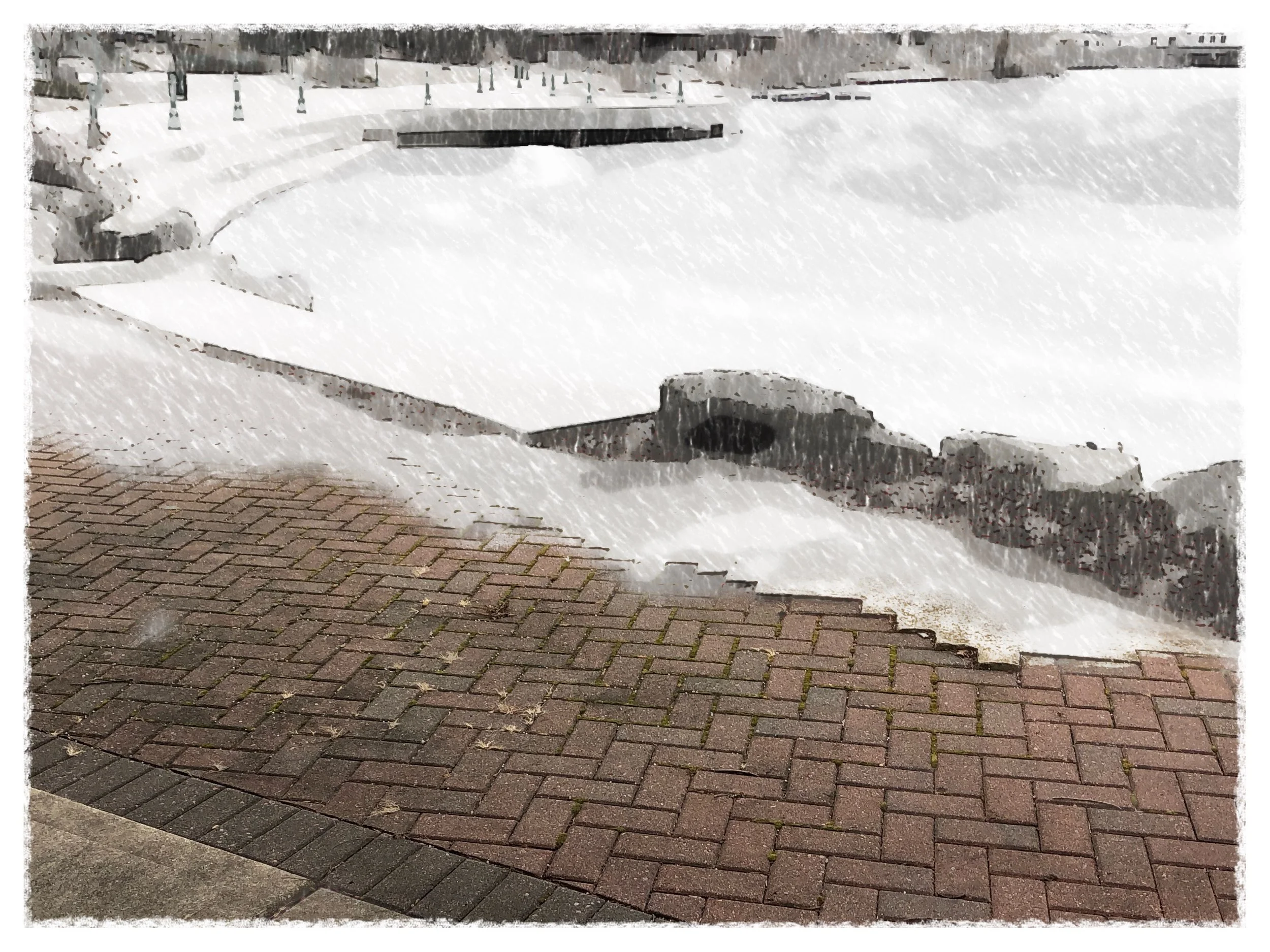Gimme Shelter
What wild weather! Pax and I had to choose our paths carefully today to avoid the worst of the cold and violent blast. And now there's snow, creating blizzard-like conditions.
As I look out at the back patio right now I see a small rabbit under the bird feeder, using his head as a shovel to get down to the spilled seed. He seems impervious to the weather.
Photo by Sue
It being the end of the iceboat season, I decided to dig out and slightly update an old writeup of the sport:
~~~~~~~~~~~~~~~~~~~~~~~~~~~~~~~~~~~~
On Iceboating
Three of us iceboat sailors were standing in a line, looking out across the lake, to some other race being held by a different class of boat. Quite suddenly, the skipper standing next to me disappeared. We three had been standing along the edge of an ice seam, where some areas can be weaker than others. Taking a step back from the seam, the two of us still standing on either side of our departed friend quickly reached down and pulled him out of the drink.
A quick transition like this from hard water to soft water is just one of the many perils of iceboating. I remember once watching a relatively new boater sail off the edge of the ice. The ice was hard and black, and this guy didn’t notice the difference between it and open water. Since iceboats don’t have brakes, a hard swerve was the best he could manage. Luckily for him, and for those of us who would have had to rescue him, his swerve was enough to keep the boat hooked on the ice by a single runner blade, and the skipper was able to climb, rather than swim, out of the boat.
Another friend of mine, an experienced sailor and successful racer, sailed into a different watery hole twice in the same afternoon. That particular hole was full of slush and thus hard to identify. But why he fell in the second time remains a topic for discussion.
There are actually very few injuries in the sport of iceboating. I once heard about a big boat that got away from its owner, sailed off on its own, and eventually ran over a fisherman, causing considerable damage. A non-iceboating friend once joined me on the ice to observe the sport, and, thanks to my negligence in not providing him with creepers, slipped and shattered his arm. I once watched a skilled sailor fail to react quickly enough to a sharp gust and tip his Nite-class boat up on its side, breaking his mast and cracking a few of his own ribs. Another skilled racing friend once destroyed both his own DN-class boat and a competitor’s by failing to avoid contact between the two, although somehow serious injury was avoided.
Of course, it would be wrong to give the impression that iceboating is nothing but disaster. It’s actually fun some of the time, and there exists a hard-core hard-water group that likes nothing better. One acquaintance has a car sporting a license plate that reads: “I Iceboat.” He lives in a village that bills itself as “The Iceboat Capital of the World.”
Putting things in perspective, there’s an old saying that iceboating is 75% tinkering, 10% bragging, and 15% waiting around for the right conditions. In other words, it’s the world’s most frustrating sport—it requires the simultaneous alignment of four impossible things: ice, an absence of snow, a temperature above 10 degrees F, and sufficient but not life-threatening wind.
Occasionally the stars do align, and then there is nothing like it.
A few years back, an early hard freeze on Crystal Lake left the lake a sheet of two-inch-thick window pane glazing. The ice was too thin to sail on, but because Crystal Lake has a wide shelf extending quite a way out from shore to the drop-off, we did so anyway, staying in the shallows, with the ice flexing dramatically under the boat as it slid almost silently along. We were able to watch fish swim by below, and when we found a muskrat under the glass we were able to follow him all the way back to his den. We did break through once…but the water was only knee deep, and everyone survived.
Sometimes when the whole lake was frozen but free of snow, we would adapt water skiing to hard water conditions, hooking up a tow-rope to the boat and having the kids put on their skates. Since slow in an iceboat is actually fast, when we’d crack the whip, the skier could let go and slide to the far horizon.
Cruising in traditional sailboats is an activity enjoyed by many, and cruising in an iceboat is also a possibility. It can be pleasant given the right conditions, but it is almost never practiced. For all intents and purposes, iceboating is all about racing, which, really, is the only way to tell if you know how to sail.
When racing, a course is set up using two marks, orange nylon pylons, set a mile or more apart along an imaginary line that represents the direction of the wind, with the windward mark directly upwind of the leeward mark. To start, the boats line up behind the leeward mark along a line perpendicular to the course. Skippers stand beside their boats, and when the flag drops, they push them ahead in a sprint, then hop in and trim the sail as quickly and smoothly as possible. From that point on it’s intense concentration mixed with intense exertion for two or three or four laps—many a hard and fast mile to the finish line.
The objective in a race is to make the boat go fast, both upwind and down. To do that the skipper has to find the perfect combination of speed, or footing; and up-course movement, or pointing. He has to play the puffs and take advantage of every wind shift. He has to be aware of all the boats around him, and adhere without fail to the somewhat arcane racing rules. He has to tack at precisely the right time (sailboats cannot go straight up wind), making sure to hit the lay-line and thus not overstand the mark or have to pinch up to get around it.
Rounding the windward mark is something else. The skipper needs to round it at the highest possible speed, preferably hiked up on two runners so that she is sling-shotted down course to the leeward mark. The G-force when rounding the windward mark can be large enough to inhibit breathing (at least temporarily).
Once at the leeward mark (sometimes without the chance to breathe a sigh of relief) she has to make a perfect turn, a smooth turn, rounding the mark without sliding sideways or spinning out, and then, once again quickly pointing as high as up wind as possible, with the sail sheeted in hard.
And all this while lying back almost flat and wearing an assortment of obstructive cold weather gear (balaclava, goggles, helmet, mittens, windproof coat and pants , spiked shoes, etc.) and going 40 or 50 or 60, or more, miles per hour.
Once I’m in the boat and have it moving well on the first upwind leg, I enjoy racing. Everything else in the world drops away and there is nothing but the present. Speed, wind, ice conditions, wind shifts, lay lines, sail trim, the other boats (especially those on starboard tack) all require a significant amount of attention.
Up to now, in spite of obstacles, and over quite a number of races, I have avoided collisions and almost always made it round the marks. One weekend some years ago I actually sailed so many races that by the last one my neck was shot— I could not, try as I might, lift it off the back deck, and I went around the course observing considerably more sky than race course.
Just to be clear, I have won some races. Quite a few, actually, I think, though I can’t remember precisely how many.
Having won races in the past, I sometimes wonder why I’m not driven to win more in the future.
Perhaps because I’m confident that I know how to sail an iceboat, and to make it go fast? Perhaps because I think I don’t need to keep proving myself to myself—or to anyone else for that matter? Perhaps.
So am I done with racing?
Well, maybe not. A day spent out on a lake in sun and wind and cold is a glorious day. There is actually something more than excitement—a sort of wild delight, at sailing four or five inches above the ice, going four or five times faster than the wind. And there’s always the thrill of, perhaps, winning yet another race.
The thing is, when you have an iceboat you are slave to a strange compulsion. As water freezes your freedom of choice diminishes. When conditions are right for iceboating you absolutely must forget everything else. Not taking advantage of something as rare and unlikely as a combination of good wind, good ice, and good competition, is like closing your eyes to a rainbow or giving up all food but tofu.
That’s why when the calendar works itself around to the middle of March I feel a certain relief. My thoughts then can turn to gardening and bike riding, and to getting soft water craft out of dry-dock and ready for launch.
Of course come October I’ll be hoping for a nice hard freeze well before Christmas.

